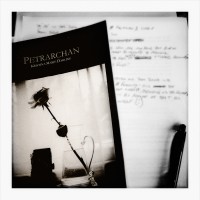25 Points: Petrarchan
 Petrarchan
Petrarchan
by Kristina Marie Darling
BlazeVOX [books], 2013
72 pages / $16.00 buy from BlazeVOX or Amazon
“Within every box, I found only compartment after compartment.”
1. Petrarchan is Kristina Marie Darling’s 8th book, published by the ever controversial Blaze Vox Books. (Yikes. Remember that whole thing? I still have love for the Vox, though.)
2. Much in the way she “took liberties with H. D.’s letters” in THE BODY IS A LITTLE GILDED CAGE, Darling uses ekphrasis, careful appropriation, erasure, and the work of Petrarch and Sappho (the latter, via Anne Carson’s translations) to achieve her grand illusion.
3. Kristina Marie Darling’s voice as a writer is unmistakable and unshaken regardless of mode or form. Of this, I am thoroughly convinced.
4. In fact, one thing that has repeatedly struck me about Kristina is how much larger in stature her writing voice is than its author. To be clear, this is not to reduce her as a person, but to exemplify her work as a force. Often, in an effort to amplify one’s voice over the din of modern media, the artist must become a personality first in order to gain potential interest in the work. Unfortunately, it becomes easy for the latter to suffer in the shadow of the former in the race. Darling reminds me that there is still a strong argument to be made as an artist for placing one’s ambitions squarely on the body of one’s art.
5. This is to say that I have no idea whose parties she attends, under which influences, et cetera, but I damn sure know when it’s her voice there on the page.
6. The reader will find in Petrarchan Darling’s familiar signature use of spare narrative and spectral imagery driving a carefully plotted course of marginalia and footnotes. To be fair, it is doubtful that anyone who is unconvinced or maybe even still undecided about her work in general will be swayed by Petrarchan. However, those of us who are believers or even simply interested parties will take comfort in knowing that what is gold still shines.
7. Tangentially, I have been thinking a lot about appropriation and erasure lately. As a writer who uses both at times almost criminally, I think a lot about what constitutes successful employment. After all, as some will invariably argue, can’t anyone do it? The short answer, of course, is yes. But to make a piece of erasure or other appropriation both successful and original despite its sources, I believe what the author chooses not to use, and why, becomes equal in importance to what is used, and how. The author must rely on the source text to some degree, but the artistic voice of the finished piece should stand on its own. Darling’s work—and Petrarchan is no exception—is as fine an example as any to underline these values.
8. I am thinking about corridors—hands and bricks or wood and the long-form sound of feet moving to some god knows where. I think about corridors a lot I think. I wonder if Kristina does too.
9. It is often easy to forget how the author implies a larger body of text with her use of marginalia as sparse narrative, set toward the bottom of the page, soaking up the white space of the specter it has picked apart.
10. Again, the ghostly presence hovering in the frame of the footnoted sections is largely the work of Francesco Petrarch, whose work I am largely unfamiliar with. I should really make it a point to change that. READ MORE >
August 13th, 2013 / 12:09 pm
